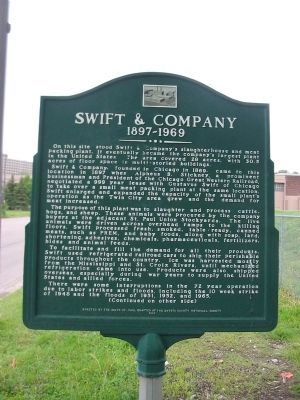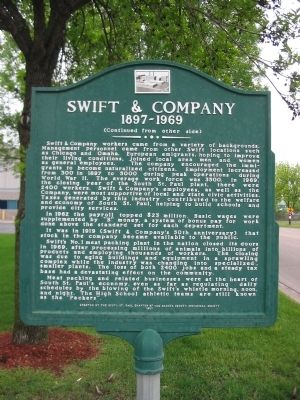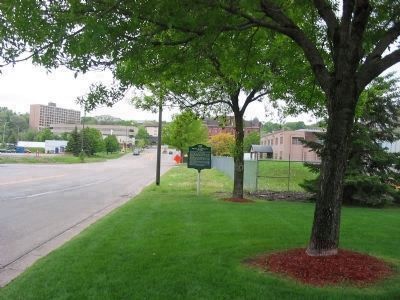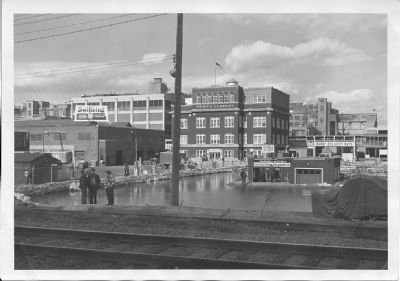South Saint Paul in Dakota County, Minnesota — The American Midwest (Upper Plains)
Swift & Company
1897 – 1969
Swift & Company, founded in Chicago in 1869, came to this location in 1897 when Alpheus B. Stickney, a prominent businessman and President of the Chicago Great Western Railroad, negotiated a 999 year lease with Gustavus Swift of Chicago to take over a small meat packing plant at the same location. Swift enlarged and expanded the capacity of the small plant’s operation as the Twin City area grew and the demand for meat increased.
The purpose of this plant was to slaughter and process cattle, hogs, and sheep. These animals were procured by the company buyers at the adjacent St. Paul Union Stockyards. The live animals were driven across overhead ramps to the killing floors. Swift processed fresh, smoked, table-ready, canned meats, such as PREM, and baby foods, along with soap, lard, shortening, adhesives, chemicals, pharmaceuticals, fertilizers, hides and animal feeds.
To facilitate and fill the demand for all their products, Swift used refrigerated railroad cars to ship their perishable products throughout the country. Ice was harvested mostly from the Mississippi and St. Croix Rivers, until mechanized refrigeration came into use. Products were also shipped overseas, especially during war years to supply the United States and allied forces.
There were some interruptions in the 72 year operation due to labor strikes and floods, including the 10 week strike of 1948 and the floods of 1951, 1952, and 1965.
(Continued on other side)
(Continued from other side)
Swift & Company workers came from a variety of backgrounds. Management personnel came from other Swift locations such as Chicago and Omaha. European emigrants, hoping to improve their living conditions, joined local area men and women as general employees. The company encouraged the immigrants to become naturalized citizens. Employment increased from 300 in 1897 to 5000 during peak operations during World War II. The average work force was 3500. In 1969, the closing year of the South St. Paul plant, there were 2400 workers. Swift & Company’s employees, as well as the Company, were most supportive of local and state civic activities. Taxes generated by this industry contributed to the welfare and economy of South St. Paul, helping to build schools and provide city services.
In 1962 the payroll topped $23 million. Basic wages were supplemented by "B" money, a system of bonus pay for work done above the standard set for each department.
It was in 1919 (Swift & Company’s 50th anniversary) that stock in the company became available to the public.
Swift’s No. 1 meat packing plant in the nation closed its doors in 1969, after processing millions of animals into billions of products and employing thousands of workers. The closing was due to aging buildings and equipment in a sprawling complex while the industry was changing into specialized, smaller plants. The loss of both 2400 jobs and a steady tax base had a devastating effect on the community.
Meat packing and related businesses were at the heart of South St. Paul’s economy, even as far as regulating daily schedules by the blowing of the Swift’s whistle morning, noon, and night. The High School athletic teams are still known as the "Packers".
Erected 1997 by the South St. Paul Chapter of the Dakota County Historical Society.
Topics. This historical marker is listed in this topic list: Industry & Commerce. A significant historical year for this entry is 1869.
Location. 44° 53.643′ N, 93° 1.931′ W. Marker is in South Saint Paul, Minnesota, in Dakota County. Marker is at the intersection of Grand Avenue and Bridgepoint Drive on Grand Avenue. Touch for map. Marker is in this post office area: South Saint Paul MN 55075, United States of America. Touch for directions.
Other nearby markers. At least 8 other markers are within 4 miles of this marker, measured as the crow flies. Armour & Company (approx. 0.6 miles away); The Stockyards
(approx. 0.6 miles away); Kaposia Village (approx. 1.8 miles away); Kaposia: Dakota Village on the Mississippi River (approx. 1.8 miles away); The Salem Evangelical Church (approx. 2.7 miles away); Battle Creek Regional Park (approx. 2.9 miles away); Holman Field (approx. 3.1 miles away); Charles W. Holman (approx. 3.1 miles away). Touch for a list and map of all markers in South Saint Paul.
Also see . . . Saint Paul Union Stockyards Company. An inventory of records at the Minnesota Historical Society. (Submitted on May 30, 2010.)
Credits. This page was last revised on June 8, 2020. It was originally submitted on May 30, 2010, by Keith L of Wisconsin Rapids, Wisconsin. This page has been viewed 5,192 times since then and 225 times this year. Last updated on March 9, 2011, by Marie Ryan of Redmond, Washington. Photos: 1, 2, 3. submitted on May 30, 2010, by Keith L of Wisconsin Rapids, Wisconsin. 4. submitted on March 3, 2011, by Marie Ryan of Redmond, Washington. • Bill Pfingsten was the editor who published this page.



